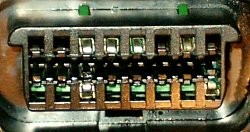Determining whether your vehicle is OBD2 compliant is crucial for accessing valuable diagnostic information and ensuring compatibility with modern scan tools. OBD2, or On-Board Diagnostics version 2, is a standardized system that allows you to monitor your vehicle’s health and performance. However, compliance isn’t solely determined by where your car was manufactured, but rather where it was originally sold. This guide will help you understand how to check if your vehicle adheres to OBD2 standards, ensuring you can effectively use diagnostic tools and understand your car’s data.
One of the most straightforward ways to ascertain OBD2 compliance is by considering the country and year your vehicle was sold. Regulations around OBD2 adoption varied globally, and understanding these timelines is key.
For vehicles sold in the United States, OBD2 compliance has been mandatory for all cars and light trucks manufactured from 1996 onwards. This was mandated by US legislation, ensuring a broad range of vehicles are compatible. You can generally assume that if your vehicle was sold in the US and is a 1996 model year or newer, it is OBD2 compliant. This encompasses a wide array of makes and models, from domestic brands to imports.
In the European Union, the rollout of OBD2 compliance was phased in based on fuel type. For gasoline (petrol) vehicles sold in the EU, full OBD2 compliance became mandatory for models from 2001 onwards, with limited compliance for some 2001 models. Diesel vehicles in the EU followed a slightly later timeline, with full OBD2 compliance required for models from 2004 onwards, and limited compliance for some models from 2004-2006. It’s important to note that “European Union” here refers to the member countries at the time these directives were implemented.
Canada adopted OBD2 standards starting in 1998. For other countries, the implementation timelines vary, often starting later than the US and EU. Countries like Australia implemented OBD2 for petrol vehicles from 2006 and diesel from 2007. Many other nations, including China, India, Mexico, and countries in the Middle East and South America, adopted OBD2 standards throughout the 2000s and 2010s, with many achieving full or limited compliance in more recent years. A detailed compatibility chart based on country of sale and model year can provide specific guidance.
While model year and country of sale are strong indicators, a definitive way to check for OBD2 compliance is to look for a Vehicle Emission Control Information label under the hood of your car. This label often explicitly states OBD-II compliance, or may use terms like OBD II, EOBD (European On-Board Diagnostics), or JOBD (Japanese On-Board Diagnostics), all of which are variations of the OBD2 standard.
Fig. 1 – A vehicle emission control information label clearly stating “OBD II Certified”, confirming the vehicle’s OBD2 compliance.
This label, usually found in the engine compartment, provides crucial emissions information and often includes the OBD compliance designation. Locating and reading this label is a reliable method to confirm compatibility directly from your vehicle.
Another resource for checking OBD2 compliance is your vehicle’s owner’s manual. This document often contains information about your vehicle’s emissions systems and diagnostic capabilities, including whether it is OBD2 compliant. Consulting your owner’s manual can provide specific details related to your car’s make and model.
It’s also important to address a common misconception regarding the 16-pin Diagnostic Link Connector (DLC). Many modern vehicles, even those predating full OBD2 compliance, feature a 16-pin connector that resembles the standard OBD2 port. The presence of a 16-pin connector does not automatically guarantee OBD2 compliance. Some manufacturers used this connector type before fully adopting the OBD2 protocol.
One way to visually differentiate between a true OBD2 compliant connector and a pre-compliance 16-pin connector is to examine the physical structure of the port. Non-EOBD compliant connectors sometimes have distinctive “ears” or slight variations in shape compared to the standardized OBD2 port.
Fig. 2 – A Ford Escort’s Diagnostic Link Connector (DLC), showcasing “ears” which are characteristic of some non-EOBD compliant connectors.
Fig. 3 – Diagram of a standard J1962 Vehicle Connector, Type A, commonly used for OBD-II compliant vehicles.
If you are still uncertain about your vehicle’s OBD2 compliance after checking these methods, it’s advisable to consult your local dealership. While some dealers may not be fully informed about the nuances between OBD and OBD2, they should be able to provide definitive information based on your vehicle’s Vehicle Identification Number (VIN).
In conclusion, determining OBD2 compliance involves checking the country and year of sale, looking for the emission control label, consulting your owner’s manual, and being aware that a 16-pin connector alone is not conclusive proof. By using these methods, you can confidently ascertain whether your vehicle is OBD2 compliant and ready for diagnostic scanning.

